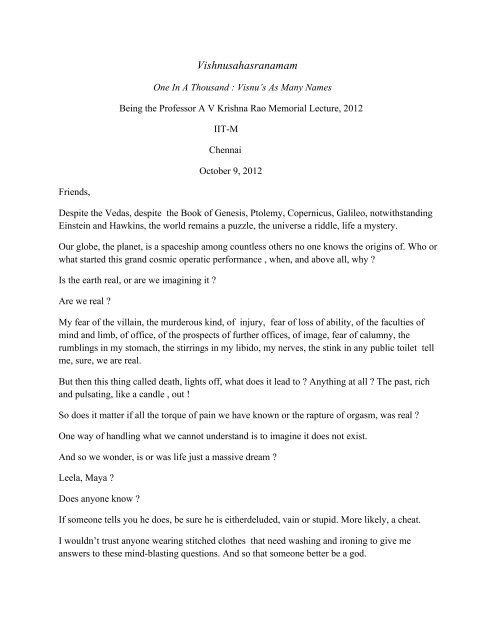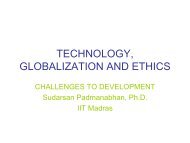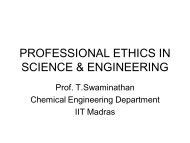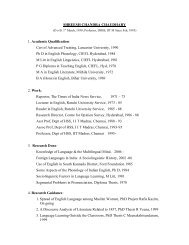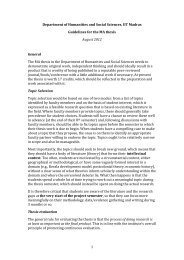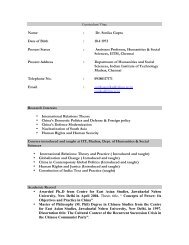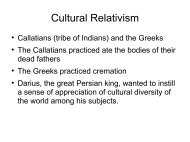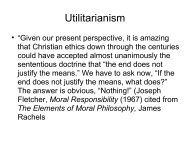Vishnusahasranamam - Department of Humanities and Social ...
Vishnusahasranamam - Department of Humanities and Social ...
Vishnusahasranamam - Department of Humanities and Social ...
Create successful ePaper yourself
Turn your PDF publications into a flip-book with our unique Google optimized e-Paper software.
<strong>Vishnusahasranamam</strong><br />
One In A Thous<strong>and</strong> : Visnu’s As Many Names<br />
Being the Pr<strong>of</strong>essor A V Krishna Rao Memorial Lecture, 2012<br />
IIT-M<br />
Chennai<br />
October 9, 2012<br />
Friends,<br />
Despite the Vedas, despite the Book <strong>of</strong> Genesis, Ptolemy, Copernicus, Galileo, notwithst<strong>and</strong>ing<br />
Einstein <strong>and</strong> Hawkins, the world remains a puzzle, the universe a riddle, life a mystery.<br />
Our globe, the planet, is a spaceship among countless others no one knows the origins <strong>of</strong>. Who or<br />
what started this gr<strong>and</strong> cosmic operatic performance , when, <strong>and</strong> above all, why ?<br />
Is the earth real, or are we imagining it ?<br />
Are we real ?<br />
My fear <strong>of</strong> the villain, the murderous kind, <strong>of</strong> injury, fear <strong>of</strong> loss <strong>of</strong> ability, <strong>of</strong> the faculties <strong>of</strong><br />
mind <strong>and</strong> limb, <strong>of</strong> <strong>of</strong>fice, <strong>of</strong> the prospects <strong>of</strong> further <strong>of</strong>fices, <strong>of</strong> image, fear <strong>of</strong> calumny, the<br />
rumblings in my stomach, the stirrings in my libido, my nerves, the stink in any public toilet tell<br />
me, sure, we are real.<br />
But then this thing called death, lights <strong>of</strong>f, what does it lead to ? Anything at all ? The past, rich<br />
<strong>and</strong> pulsating, like a c<strong>and</strong>le , out !<br />
So does it matter if all the torque <strong>of</strong> pain we have known or the rapture <strong>of</strong> orgasm, was real ?<br />
One way <strong>of</strong> h<strong>and</strong>ling what we cannot underst<strong>and</strong> is to imagine it does not exist.<br />
And so we wonder, is or was life just a massive dream ?<br />
Leela, Maya ?<br />
Does anyone know ?<br />
If someone tells you he does, be sure he is eitherdeluded, vain or stupid. More likely, a cheat.<br />
I wouldn’t trust anyone wearing stitched clothes that need washing <strong>and</strong> ironing to give me<br />
answers to these mind-blasting questions. And so that someone better be a god.
2<br />
The art <strong>and</strong> science <strong>of</strong> aesthetics, which includes music, literature, epic as well as more modest<br />
writing , <strong>and</strong> all the performing arts, the fine arts <strong>and</strong> much more , have all tried to grapple with<br />
these issues.<br />
The Vishnusahasranamastotram , with its 142 verses beginnignwith a dialogue between Bhishma<br />
<strong>and</strong> Yudhishthira, , has its home in the Anusasanika Parva <strong>of</strong> the Mahabharata. It combines,<br />
along with other Sahasranama Stotras such as those to Devi <strong>and</strong> to Siva the tonality <strong>of</strong> music, the<br />
sonority <strong>of</strong> chanting, the textuality <strong>of</strong> literature <strong>and</strong>, above all, the honesty <strong>of</strong> facing the riddle <strong>of</strong><br />
the universe with guts, with wit, with vision. In other words, with all that it takes a master<br />
musician, a master philosopher, a master sculptor or a masterly aeronautical engineer to create a<br />
masterpiece.<br />
The Stotram – as I shall call the work hereafter – is for me primarily a work <strong>of</strong> aesthetic creation<br />
<strong>and</strong> I shall <strong>of</strong>fer a few remarks on it today, as such. ‘Aesthetic’, as you know, is the adjective for<br />
aesthesia or aesthesis which means feeling, sensitivity, a sense <strong>of</strong> sensation. Its opposite is<br />
anaesthetic, the sense-killer. The Stotram uses text that is visual <strong>and</strong> invests it with sonority to<br />
give us an example <strong>of</strong> the aesthetics <strong>of</strong> philosophical postulation. It does this through the art <strong>of</strong><br />
composing in a genre that is at once literary <strong>and</strong> musical. It <strong>of</strong>fers some thoughts on the<br />
existential questions I posed, but not in self-delusion, vanity or hypocrisy. It does so differently.<br />
A Stotra is a chant. A chant is made up <strong>of</strong> a word or a phrase that is not prose, not poetry. It is<br />
not spoken, not sung. It is intoned. A japa is an intonation . It repeats a sound, repeats the<br />
repeated, almost hypnotizing the repeater <strong>and</strong> anyone listening. If accompanied by the<br />
movement between one’s fingers <strong>of</strong> a rosary, a japa combines the hum <strong>of</strong> sonority with the thrum<br />
<strong>of</strong> tactility to induce a multi0mode acceptance. This Stotram does that, but differently <strong>and</strong> with<br />
different results. It is an unusual specimen <strong>of</strong> the aesthetics <strong>of</strong> sound <strong>and</strong> the meaning being<br />
conveyed though that sound.<br />
Aesthetics like yoga, have stances. We may call them asana-s. If one aesthetic asana is formal <strong>of</strong><br />
structure <strong>and</strong> classical like Carnatic music another has a repose to its svarupa <strong>and</strong> an ease to its<br />
svabhava, like the songs <strong>of</strong> saint-singers like Meera, Tulsidas, Tukaram <strong>and</strong> Kabir, <strong>and</strong> <strong>of</strong> the<br />
Bauls <strong>of</strong> Bengal who sing as they dance, dance as they sing.<br />
Indian Institutes <strong>of</strong> Technology also have their own stances <strong>and</strong> asana-s. Teaching exact, precise<br />
<strong>and</strong> empirical subjects, IIT <strong>Department</strong>s are akin to the classical arts, to what may be seen as<br />
formal <strong>and</strong> structured yogic asana-s. In yogic terminology, the mainstream departments <strong>of</strong> IITs<br />
are like the extremely evolved <strong>and</strong> tractional Suryanamaskar which stretches <strong>and</strong> tenses the<br />
human anatomy to its greatest scope.
3<br />
I would say if a <strong>Department</strong> <strong>of</strong> Electrical Engineering in an IIT has a yogic co-relative in the<br />
Vajrasana <strong>and</strong> the <strong>Department</strong> <strong>of</strong> Mechanical Engineering in the Sarvangasana, a <strong>Department</strong> <strong>of</strong><br />
<strong>Humanities</strong> in an IIT corresponds to the de-tensing yogic procedure where the mind <strong>and</strong> body are<br />
in un-agitated <strong>and</strong> yet restorative repose, namely, the Pranayama.<br />
Let us assume for an incredible moment that the IIT-Madras was a campus which teaches the<br />
highly codified form <strong>of</strong> music in the Carnatic tradition. The mainstream departments there would<br />
be teaching the structure <strong>of</strong> raga-s <strong>and</strong> kriti-s. The equivalent <strong>of</strong> a <strong>Department</strong> <strong>of</strong> <strong>Humanities</strong> in<br />
such an IIT would teach kirtana-s. The kirtana or bhajan is no less <strong>of</strong> a composition, no less<br />
exacting <strong>and</strong> meticulously formed than a mela or ghana raga. When Sangita Kalanidhi M S<br />
Subbulakshmi , for instance, moved from a Pantuvarali or a Brindavana Saranga to a Meera<br />
bhajan , the audience also moved – from measuring her musical pace in tala-s to savouring her<br />
devotion’s grace in bhava. The matra <strong>of</strong> judgment was replaced during her singing <strong>of</strong> a bhajan by<br />
an un-judgmental but fully cognizant surrender which while stressing the devotional text<br />
remained, needless to say, essentially, musical.<br />
Likewise, today, when an artist <strong>of</strong> the creative vision <strong>and</strong> artistry <strong>of</strong> Vidvan T.M.Krishna<br />
weaves into a traditional ragam-tanam-pallavi concert a heart-wrenching viruttam by<br />
Tirumangai Azhvar or the Narayananamu Namu by Narsinh Mehta, the audience goes through<br />
an aesthetic re-configuration in which music remains paramount but opens the door <strong>of</strong><br />
appreciation wider for text-based verbal attunement, giving itself over from delectation <strong>of</strong> form<br />
to ecstasy <strong>of</strong> spirit.<br />
If the <strong>Department</strong> <strong>of</strong> <strong>Humanities</strong> in the IIT-Madras is where technology settles down to a<br />
differentiated rhythm in breathing, like a kirtanai in a Carnatic concert, we have to thank,<br />
acknowledge <strong>and</strong> honour Pr<strong>of</strong>essor A V Krishna Rao. It is a privilege for one like me to be<br />
asked to give this Memorial Lecture commemorating him. I pray that I may deserve this<br />
privilege.<br />
Pr<strong>of</strong>essor Krishna Rao <strong>and</strong> I are linked with nothing but our names, which derive from the stock<br />
<strong>of</strong> Vishnu’s several name-attributes to which our parents turned like the good devotees <strong>of</strong> Vishnu<br />
that they were. My use <strong>of</strong> the expression ‘I pray’, a moment ago, may make some <strong>of</strong> you think I<br />
am a religious person. I am not, not in the sense <strong>of</strong> being a traditional temple-goer or practitioner<br />
<strong>of</strong> rites <strong>and</strong> rituals. I am moved by what may be called religion, when I see the position on the<br />
Universal Spirit <strong>of</strong> highly intelligent persons like Ramana Maharshi, Sri Aurobindo, G<strong>and</strong>hi,<br />
Rajagopalachari <strong>and</strong> Radhakrishnan – all ‘Medhavi-s’ (77) – <strong>and</strong> at the other end <strong>of</strong> the<br />
spectrum the faith <strong>of</strong> simple devotees as they worship at temples, trudging long distances <strong>and</strong><br />
waiting for long hours for a darshan. Interestingly, Bhaktavatsala is a stotra name, at 736.
4<br />
I have also been greatly affected by the extraordinary power that seems to dwell in <strong>and</strong> breathe<br />
from many religious venues. I have been struck more by their architectural <strong>and</strong> historical<br />
settings than by their religious gravitas though, ever so <strong>of</strong>ten, the religious magnetism <strong>of</strong> some<br />
<strong>of</strong> them like the Anantapadmanabhaswami Temple in Thiruvananthapuram , has astonished me.<br />
‘Ananta’, needless to say, is traceable to the Stotram at 886 <strong>and</strong> ‘Padmanabha’ at two positions,<br />
48 <strong>and</strong> 196. But I am nauseated by the filth, the hypocrisy <strong>and</strong> the monetization that disfigures so<br />
many places <strong>of</strong> worship.<br />
I am unable to overlook the fact that the relentless growth in the number <strong>of</strong> such shrines in our<br />
country has less to do with devotion than with business, is less inspired by the power <strong>of</strong> the<br />
Creator than that <strong>of</strong> the cement trade <strong>and</strong> that the large-scale eruption <strong>of</strong> these pustule-like<br />
structures is aesthetically valueless, spiritually hollow <strong>and</strong>, in terms <strong>of</strong> civic planning <strong>and</strong> urban<br />
management, nothing less than sc<strong>and</strong>alous.<br />
Who can miss the fact that cooking, eating <strong>and</strong> selling food occupies a major chunk <strong>of</strong> time in<br />
<strong>and</strong> around shrines ? This has a natural corollary that I need not describe, making the resultant<br />
stench all but overwhelm the gentler aromas <strong>of</strong> incense. You may not believe this – I cannot –<br />
but the Stotram has a name for Vishnu that is ‘spot on’ on this. ‘Analah’, 293 according to<br />
Sankara means the One who is odourless. The phenomenon <strong>of</strong> priests in almost every religion,<br />
with great exceptions, tending to be overweight <strong>and</strong> under-exercised has regularly disappointed<br />
me. This has also reminded me <strong>of</strong> the fact that one <strong>of</strong> Vishnu’s thous<strong>and</strong> names is indeed<br />
Bhojanam (142) <strong>and</strong> another , following immediately after Bhojanam, is Bhokta (143), meaning<br />
‘that which is eaten or enjoyed, <strong>and</strong> ‘that which eats or enjoys’.<br />
Such being the case, if one like me can still be drawn to a particular text <strong>of</strong> obviously religious<br />
origin, nature <strong>and</strong> purport, there have to be some reasons. And if I then proceed to inflict my<br />
views on such a text on highly knowledgeable <strong>and</strong> thinking people in a public lecture, those<br />
reasons have to be very good reasons.<br />
Let me set my choice <strong>of</strong> theme in perspective. For one born to parents pr<strong>of</strong>essing Vaishnava<br />
beliefs, I have been <strong>and</strong> am pre-disposed towards Vaishnavite literature.The compositions <strong>of</strong><br />
Tulsidas, Surdas, Meera in the North Indian tradition, <strong>of</strong> Narsinh Mehta in the Western Indian, <strong>of</strong><br />
Chaitanya in the Eastern <strong>and</strong> <strong>of</strong> Pur<strong>and</strong>ara <strong>and</strong> Tyagaraja in the Southern were a passive part <strong>of</strong><br />
my aesthetic <strong>and</strong> cultural imagination. The arrival in the 1960s <strong>of</strong> M.S. Subbulakshmi’s record <strong>of</strong><br />
the Stotram made me alive to this work. That someone could recite the whole <strong>of</strong> the tonguetwisting<br />
, heavily alliterated composition at one go <strong>and</strong> at great speed without tripping on a<br />
single aspirant, sibilant , vowel or consonant seemed to me a miracle. Perhaps there were breaks<br />
<strong>and</strong> re-takes during the recording which technology smoothed.
5<br />
Dr Gowri Ramnarayan tells me Agnihotram Ramanuja Thathachariar, the great Vaishnavite<br />
scholar was called in to check the recording <strong>of</strong> the Stotram for its pronunciation <strong>and</strong> after<br />
hearing MS’s rendering said “even Agnihotris cannot aspire to MS's diction – pure, flawless,<br />
resonant with nadam”.<br />
But I must say something here which could sound subversive. In the very raciness <strong>of</strong> her<br />
flawless rendering, in the Rajdhani or Shatabdi-like pace <strong>of</strong> her breathless non-stop Duranta<br />
journey to Vishnu, MS does not permit us to view the names, see their pr<strong>of</strong>iles, their<br />
roundedness, their inner meaning. This is a pity, for the Stotram is unlikely ever to be recorded<br />
again in the voice <strong>of</strong> someone <strong>of</strong> MS’ stature. It deserves reflection, not recitation. It calls for<br />
thought, not rote.<br />
Japam may be good therapy, but it trivializes the word. High-speed japam does worse. It tears<br />
the concept to smithereens, like a shredding machine.<br />
Yet, hearing MS’s rendering stirred nodes <strong>of</strong> wonderment lying inert on the floor <strong>of</strong> my subconscious.<br />
She linked those unsounded pellets in my slumbering deep to the sky <strong>of</strong> the<br />
Storam’s cosmic imagination. The names or attributes that she delivered like sparks , I could<br />
see, were cosmic truths speeding past the firmament like shooting stars. It occurred to me that<br />
Vishnu’s thous<strong>and</strong> names may be as many religious attributes but they were also were also<br />
astrophysical verities, ecological vignettes, existential truths. And I wanted to reach out to them.<br />
If only MS had sparkled the stars not in alliterative triumphalism but in a slow-motion cosmic<br />
probe <strong>of</strong> Vishnu’s many in one <strong>and</strong> one in many, names !<br />
Vishnu’s alternative names are, in unaesthetic language, aliases – Vishnu aka Krishna aka<br />
Govinda aka Keshava – <strong>and</strong> could even be seen as alibis running away from a fixed identity.<br />
‘Krishna’ is , <strong>of</strong> course, one <strong>of</strong> the thous<strong>and</strong> names , occurring twice ( 57, 550) , with ‘Ramah’<br />
featuring austerely but once (394). ‘Vishnu’ itself occurs three times in the series ( 2, 258,<br />
657),in a relative frugality considering that ‘Vishnu’ is the object <strong>and</strong> subject <strong>of</strong> the entire<br />
exercise.<br />
The given names <strong>of</strong> a good number <strong>of</strong> persons in this hall are likely to traceable to the Stotram.<br />
Taking one alphabet , ‘A’ alone, there is bound to be an Aditya (39,563) here, an Ajit (549), Anil<br />
(234,812), Ashok (336), Atul (355). As also an Amrita (119), An<strong>and</strong>i (560). Well, all those occur<br />
in the Stotra. Names that occur rather more in this part <strong>of</strong> the country than in the north may also<br />
be found in the Stotram – Dhananjaya (660), Janardana (126). The last two being the given<br />
names <strong>of</strong> two distinguished Gurus <strong>of</strong> Bharatanatyam <strong>and</strong> Kathakali. For that matter the word<br />
‘Guru’ itself is a Stotra name (209). That <strong>of</strong> IIT-M’s guru <strong>of</strong> guru-s, its Director, is <strong>of</strong> course a<br />
Stotram -sanctioned name, with ‘Bhaskara’ as ‘Bhaskaradyutih’ occurring at position 282.
6<br />
May I add that Pr<strong>of</strong>essor Shreesh Chaudhary’s given name is also found in the list as ‘Srisah’<br />
at 606. Pr<strong>of</strong>essor Chella Rajan has escaped by virtue <strong>of</strong> his pure Tamil first name ‘Chella’ but,<br />
if translated or restored to the Sanskrit, ‘Priya’, even he would figure at 872 <strong>and</strong> 874, Priyarhah<br />
<strong>and</strong> Priyakrit.<br />
The Stotram is a parent document in which repose a good number <strong>of</strong> names <strong>of</strong> Vaishnavite<br />
character, not unlike a register <strong>of</strong> births which the Aadhaar scheme inectricably associated with<br />
the brilliant N<strong>and</strong>an Nilekani may study as a reference-text. N<strong>and</strong>an would be interested to<br />
know that before he gets an Aadhaar number, he already has one occurring, at 527 <strong>and</strong> 528 <strong>of</strong> the<br />
Stotram. Why, Aadhaar itself is a Stotra name, with ‘Aadhaaranilayah’ at 7 meaning the support<br />
<strong>of</strong> supports, the basis , the foundation.<br />
But it is not its listing <strong>of</strong> orthodox list <strong>of</strong> names or proper nouns for devout Vaishnavites to refer<br />
to at namakaranams ,that makes the Stotram so valuable. It is in what the listing does that makes<br />
it so. As Eknath Easwaran reminds us , Bhishma tells Yudhishthira in the Mahabharata : “I shall<br />
recite the Thous<strong>and</strong> Names. Listen carefully, <strong>and</strong> they will remove fear <strong>and</strong> evil from your life”.<br />
From what I know <strong>of</strong> fear <strong>and</strong> <strong>of</strong> evil, I can say that they are not that easy to remove. But if<br />
underst<strong>and</strong>ing some <strong>of</strong> the roots <strong>of</strong> both can be a method <strong>of</strong> starting the process, then exploring<br />
the names for their underlying significance is hugely rewarding. And the roots lie in the ideas it<br />
puts forward, <strong>of</strong>ten self-contradictorily, <strong>of</strong> the whys <strong>and</strong> wherefores <strong>of</strong> Creation. Selfcontradiction,<br />
inconsistency, is in fact one <strong>of</strong> the attributes <strong>of</strong> the Stotram. Its descriptions show<br />
Vishnu to be kind, to be cruel. He is fire, he is water. He is anger, he is calm. He is subtle, he is<br />
simple. He is the past, he is the future.<br />
What is one to believe ?<br />
Make up your mind, Mahavishnu ! Inconsistency does no credit to us, humans, why <strong>and</strong> how<br />
must it be such an ornament in you ?<br />
Mahatma G<strong>and</strong>hi was a Believer, a vaishnavite, not a philosopher. Yet , his masterful description<br />
<strong>of</strong> God is one that could have come from an Einstein if not a Russell. Writing in ‘Young India’<br />
on 11.10.1928 he said : “I do dimly perceive that whilst everything around me is ever-changing,<br />
ever-dying, there is underlying all that change a living Power that is changeless, that holds all<br />
together, that creates, dissolves, <strong>and</strong> re-creates”.<br />
G<strong>and</strong>hi is not known to have read the Stotram but I find it felicitous that the Stotram has an entry<br />
with a near-exact meaning for almost every segment <strong>of</strong> his definition: Dimly perceive (or not<br />
explicit, invisible) = Achintya , 832 , Agrahyah, 55 , Amurtiman , 720, Anadih, 941 ;<br />
Everything around me = Sarvadarsanah , 94 ; Underlying all = Paryavasthitah, 931;
7<br />
Living Power = Pranah, 66, Jivah, 513 <strong>and</strong> Jivanah, 930; Changeless = Aksharah, 17, Achyutah<br />
, 100, 318 <strong>and</strong> Sasvata-sthirah , 627; Holds all together = Bhutabhrit, 6 <strong>and</strong> Vishvadhrik , 238 ;<br />
Creates, dissolves, re-creates = Bhutakrit, 5.<br />
A work as broad <strong>of</strong> sweep as the Stotram cannot be confined to one religious or faith tradition.<br />
The descriptions <strong>of</strong> Vishnu as formless have to appeal to other faiths which do not believe in a<br />
God with a human morphology. John Donne has said in one <strong>of</strong> his Divine Poems :<br />
‘Eternall God, (for whom who ever dare<br />
See the new expressions doe the circle square<br />
And thrust into strait corners <strong>of</strong> poor wit<br />
Thee who are cornerless <strong>and</strong> infinite)’<br />
What does this concordance between a non-conforming nd non-traditional Believer who was<br />
drawn to other faiths like Christianity, Islam, Buddhism, Jainism <strong>and</strong> the great teachings <strong>of</strong><br />
Zoroaster, namely,G<strong>and</strong>hi <strong>and</strong> the Stotram show ? That G<strong>and</strong>hi intuitively was a Stotra-adherent,<br />
that the Stotram anticipated a great man’s twentieth century definition ? No. It shows that the<br />
Stotram is a work <strong>of</strong> philosophical imagination, <strong>of</strong> cosmic enquiry, <strong>of</strong> galactic speculation <strong>and</strong><br />
hypothesising, which complements the Vedas, <strong>and</strong> can be a brilliant backdrop to recurring<br />
engagements with the question <strong>of</strong> Creation <strong>and</strong> <strong>of</strong> Existence. More, that it <strong>of</strong>fers not one<br />
hypothesis but , in its seeming contrarinesses <strong>and</strong> contradictions, several schools <strong>and</strong> in fact<br />
faculties <strong>of</strong> enquiry.<br />
Pr<strong>of</strong>essor Amartya Sen has written ( Amrtyuh, incidentally, is at Stotra 198) about how the Rig<br />
Veda asks difficult questions regarding ‘the very creation <strong>of</strong> the world’, one <strong>of</strong> which is:‘Who<br />
really knows ? Who will here proclaim it ? Whence was it produced ? Whence is this<br />
creation?...perhaps it formed itself, or perhaps it did not – the one who looks down on it, in the<br />
highest heaven, only he knows – or perhaps (even) he does not know…’<br />
According to widely accepted time-lines, the Rig Veda was composed sometime between 1500<br />
<strong>and</strong> 1000 BC, <strong>and</strong> the Mahabharata (<strong>of</strong> which our Stotra is part) a little later. Be that as it may, I<br />
find it significant that the Stotra which denies itself the advantage <strong>of</strong> narrative argumentation <strong>and</strong><br />
syntactical expression that the Rig Veda enjoys, <strong>and</strong> is only a bare-bones list, nevertheless,<br />
manages to convey the wonder <strong>of</strong> Creation <strong>and</strong> the equal wonder at there being more than one<br />
possibility as to its origins.
8<br />
No religious skeptic, agnostic or even an atheist can but feel, at some point in time, on some<br />
occasion or other, a sense <strong>of</strong> there being a Power in the universe higher than the highest ether his<br />
brain can visualise <strong>and</strong> further than the farthest galaxy his remote sensing lenses can discern.<br />
And even if such a humbling thought has not occurred to the unbeliever – a most unlikely<br />
circumstance – he is bound to have felt in some hour <strong>of</strong> distress or moment <strong>of</strong> reflection that it<br />
would be good if such a Power – like a Supreme Court – did exist Yon High comm<strong>and</strong>ing a<br />
reliable down-linking network. The word ‘network’ brings to mind cables, wires <strong>and</strong> suchlike<br />
appliances <strong>of</strong> the 21 st century, does it not ? Well, believe it or not, the Stotram has a name for<br />
precisely that very facility – Vishnu is described as ‘Sutantuh’ (784). Tantu , as you know <strong>and</strong> as<br />
Vaman Shriram Apte explains in his Sanskrit to English Dictionary, means thread, cord, wire,<br />
string. Adi Sankara says “As this Universe <strong>of</strong> infinite extension belongs to Him, the Lord is<br />
called Sutantu”.<br />
There can be other conditions as well when the Creator is instinctively invoked <strong>and</strong> by the most<br />
unlikely persons. The nuclear age – our age – may be said to have begun on the 16 th <strong>of</strong> July, in<br />
1945.Not one but three things happened on that day, giving the world’s its nuclear teeth.<br />
The first was a meeting, at Potsdam, attended by statesmen from the world’s future nuclear<br />
powers – US President Harry Truman, the Soviet supremo Joseph Stalin, <strong>and</strong> British Prime<br />
Minister Winston Churchill. The meeting played with fire.<br />
The second was a testing, the world’s first, <strong>of</strong> a nuclear device took place, in complete secret, the<br />
very same day at Los Alamos, New Mexico, witnessed by J.R.Oppenheimer, Director <strong>of</strong> the<br />
Project, the physicist Kenneth Bainbridge, <strong>and</strong> a few carefully selected scientists <strong>and</strong> military<br />
personnel. At the moment <strong>of</strong> detonation, the ground swelled, shook, pummeled, rose <strong>and</strong> fell,<br />
sending up a plume <strong>of</strong> light so bright that every blade <strong>of</strong> grass in the vicinity stood out in the<br />
sharpest <strong>and</strong> most eerie relief. The test was about fire.<br />
The third was a sailing. A US cruiser, Indianapolis sailed that day from San Francisco for<br />
Tinian Isl<strong>and</strong> on the South Pacific on a mission that was directly related to both those<br />
proceedings. Carrying in large wooden crates parts <strong>of</strong> a device the Captain <strong>and</strong> crew knew was<br />
important but not how important – or how ugly. From Tinian, bombers were to take <strong>of</strong>f with the<br />
device, none other than the “powerful new weapon”, for its twin destinations in Japan, ending<br />
the war <strong>and</strong> starting our age, the nuclear age. And all this happened on the very same day.The<br />
vessel reached Tinian Isl<strong>and</strong>, <strong>of</strong>f-loaded its cargo <strong>and</strong> sailed casually <strong>of</strong>f, on 29 July. Its<br />
operation had been kept so secret that it was on no Allied radar. This was, for the Indianapolis<br />
crew, a disastrous folly.
9<br />
A Japanese I-58 submarine sniffed the unprotected Cruiser <strong>and</strong> creeping up to firing range,<br />
rammed two torpedoes into it. Within fifteen minutes, the 9800 tonne vessel with formidable<br />
speed <strong>and</strong> fire power was under water, 880 <strong>of</strong> its 1196 crewmen sinking with her. Worse was to<br />
follow. As the survivors grouped together, holding h<strong>and</strong>s, hoping to be spotted by US Navy or<br />
Air Force craft, Tiger Sharks smelt human blood <strong>and</strong> before anyone could react, two or three<br />
hundred <strong>of</strong> those “eating machines” were upon them.<br />
What does this set <strong>of</strong> three happenings on July 16, 1945 have to do with the<br />
Srivishnusahasranamastotram ?<br />
Nothing, really.<br />
And everything.<br />
At the level <strong>of</strong> names, the three – meeting, testing <strong>and</strong> sailing – all have echoes in Vishnu’s<br />
names. Believe it or not, ‘meeting’ occurs as ‘samiti’ in ‘Samitinjayah’, at 362, ‘testing’ <strong>and</strong> that<br />
with fire can be visualized in Yajnah, 971 while ‘sailing’ is echoed in ‘Tarah’, at 968 which<br />
refers to ‘One who helped jiva-s to go across the ocean <strong>of</strong> Samsara’. But , you might well ask, is<br />
that linkage not perverse considering that the meeting, the testing <strong>and</strong> the sailing were essentially<br />
horrible events with horrible results for humanity <strong>and</strong> for individual humans ? So they were.<br />
But that is where the Stotram rises , within the imagination <strong>of</strong> the reader, or the recite, above<br />
being a book <strong>of</strong> l<strong>of</strong>ty names to a point <strong>of</strong> departure for thoughts about Creation , a Creation<br />
that is at once sublime <strong>and</strong> sordid, beatific <strong>and</strong> bizarre, transcendent <strong>and</strong> tragic. It has to be seen<br />
as a work with an alpha-numeral title that can help us see , dichotomously, the shade beneath the<br />
light <strong>of</strong> living on this planet. I believe the Stotram must be read by a bewildered humanity not to<br />
get de-bewildered but to find in its pages <strong>and</strong> name-entries resources for interrogating that very<br />
bewilderment. One <strong>of</strong> the names <strong>of</strong> Vishnu is ‘mangalam-param’, 63. There can be no concept <strong>of</strong><br />
mangalam without there being something that is a-mangalam, even as there can be no light<br />
without darkness to contrast it with.<br />
I spoke <strong>of</strong> the world’s first testing <strong>of</strong> a nuclear device. That anti-epiphanic event led to all that<br />
we know. But in its authors, it also led to a certain self-interrogating <strong>and</strong> self-chastising moment.<br />
The test took place, as we know, in complete secret, at Los Alamos, New Mexico. Incidentally,<br />
the Stotram has not one but two names for that which is secret – ‘Guhyah’, 542 meaning that<br />
which is esoteric <strong>and</strong> hidden, <strong>and</strong> ‘Guptah’, 545 again meaning that which is hidden. But to<br />
return to that test <strong>and</strong> the effect it produced on its authors.
10<br />
Please recall the Stotram’s word ‘yajnah’ <strong>and</strong> imagine a yajnah <strong>of</strong> proportions so great as to leap<br />
out <strong>of</strong> or sink into the allocated yajna’s space. Yajna-s in our mythology were performed by the<br />
good <strong>and</strong> the beastly. I am not saying Oppenheimer or Bainbridge were that creature ; they<br />
certainly were not. Who was the ‘beast’ behind the bomb ? There was not one but many beasts<br />
<strong>and</strong> I am not referring to people. Human fear, human suspicion, human hatred were among the<br />
beasts. Here I must refer to the entry at 314, namely, ‘Krodhakrit-karta’ which Sankara describes<br />
as meaning ‘One who generates krodha or anger in evil people’. And so, what does one make <strong>of</strong><br />
the Stotram’s giving Vishnu the name <strong>and</strong> attribute <strong>of</strong> the author <strong>of</strong> krodha among evil people ?<br />
When the Atom Bomb-yajna took place with all the mind-blasting physical features I have<br />
described, Oppenheimer is believed to have said, quite simply, “It worked”. But later, he was to<br />
turn famously to the Bhagavad Gita <strong>and</strong> quote its line: “I am become Death, the Destroyer <strong>of</strong><br />
Worlds”. But Bainbridge’s reaction, much less known , was no less significant. Turning to<br />
Oppenheimer at the site at the very moment , he said “Now we are sons <strong>of</strong> … all”. I have left out<br />
the crucial word, out <strong>of</strong> respect for the maryada <strong>of</strong> a memorial lecture but you can all guess it.<br />
The Stotram, needless to say, has no space for that four-legged fellow-being <strong>of</strong> ours.<br />
Robert Frost has a remarkable poem, Fire <strong>and</strong> Ice :<br />
Some say the world will end in Fire, some say in Ice.<br />
From what I know <strong>of</strong> desire I hold with those who favour Fire.<br />
But from what I know <strong>of</strong> hate I think I know enough <strong>of</strong> hate<br />
To say that Ice is also great <strong>and</strong> would suffice.<br />
Let us see India’s great texts , regarded by us as religious, as something much more than that.<br />
They are intellectual <strong>and</strong> aesthetic resources that may or may not lead us to devotion, piety or<br />
Grace, but which carry in them seeds <strong>of</strong> extraordinary wisdom, great with <strong>and</strong> a tantalising<br />
ambivalence, drawn from humankind’s integrated perceptions, that can lead us to face the<br />
questions I started <strong>of</strong>f with. And which can, thereby, be <strong>of</strong> physick, <strong>of</strong> medicament to our clearly<br />
diseased times. ‘Aushadham’ is one <strong>of</strong> Vishnu’s names. It also has Asvatthah, 824 – the longliving<br />
peepul tree, associated with the Buddha.<br />
Oscar Wilde is the lst person one would think <strong>of</strong> when discussing the Stotra. And yet his lines in<br />
De Pr<strong>of</strong>undis compel referencing. ‘Society’, he says, ‘will have no place for me…but Nature will<br />
have clefts in the rocks where I may hide...She will hang the night with stars…cleanse me in<br />
great waters <strong>and</strong> with bitter herbs make me whole…’
11<br />
The Stotram too is an aushadham which with is herbs, bitter <strong>and</strong> otherwise can make us whole.<br />
And it has clefts in its rocks where we may hide with our fears <strong>and</strong> our hopes. Let us not read it<br />
hypnotised by its sonority but with the respect that a great witness <strong>of</strong> the transactions <strong>of</strong> life<br />
deserves. That may be Vyasa., or many Vyasa-s. My favourite entry in the stotram is ‘Saksi’,<br />
15 meaning (according to Sankara) ‘One who witnesses everything’.<br />
The Srivishnusahsranamastotram is about witnessing. It is about experiencing. It is about life. It<br />
is about what we are, in our multiplicities, in our complexities, in our one thous<strong>and</strong> natures. It is<br />
about the astral in us, about the celestial in us, about the terrestrial in us. It is about the real in us,<br />
who are not Vishnu but in whom Vishnu, if He dwells anywhere, must dwell.<br />
References <strong>and</strong> Acknowledgings:<br />
1. Sri Vishnu Sahasranama with Sankara’s commentary as trabslated into english by swami Tapasyan<strong>and</strong>a for<br />
Sri Ramakrishna Math, Mylapore, Madras, 1987.<br />
2. The Bhashya <strong>of</strong> Sri Sankaracharya as translated by Sri R.Ananthakrishna Sastry for The Adyar Library <strong>and</strong><br />
Research Centre, Madras,1980.<br />
3. A Thous<strong>and</strong> Names <strong>of</strong> Vishnu, by Eknath Easwaran, Jaico, 1997.<br />
4. Commentary on the Srivisnusahasranamastotram by C.Sivaramamurti, 1978.<br />
5. Vaman Shivram Apte’s Sanskrit-English Dictionary, 1890, republished by Motilal Banarsidas, 2000.<br />
6. Sanskrit – An Introduction’, 1976, by Michael Coulson <strong>and</strong> Richard Gombrich.<br />
7. Dr Gowri Ramnarayan for insights into M.S.Subbulakshmi’s recordings.<br />
8. Vidvan T M Krishna for insights emanating from his recording in three CDs <strong>of</strong> ‘Narayana – Kritis on Lord<br />
Vishnu’, 2007 (Rajalakshmi Studios, Coimbatore).<br />
9. Shri Karunaker Menon for loan <strong>of</strong> relevant books.<br />
10. Shri Govind Venkatesan for assistance in preparing the reading text.


